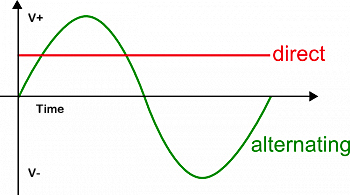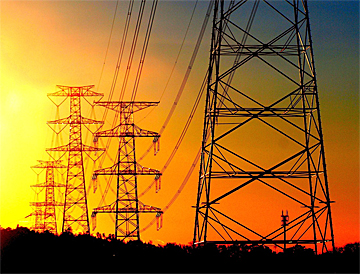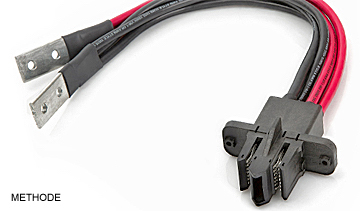Direct Power Transmission: Did Edison Get it Right?
The battle between AC and DC power may be fought all over again as rising demand for power and new technologies converge, bringing attention to direct current’s technical and economic advantages.
After a nasty publicity battle between George Westinghouse and Thomas Edison, alternating current (AC) was selected as the electrical power transmission standard for the world. Aided by the discoveries of Nikola Tesla, distributing high-voltage AC was proven to be more efficient than direct current (DC). Now, 155 years later, that decision is being reconsidered.
According to Ohm’s law (P= I²R), the amount of loss in a power line is proportional to the square of the current. By increasing the voltage, the current is reduced, making it much more efficient. At the time, it was difficult to raise or lower the voltage of generated DC power. To minimize loss, Edison’s direct current system would have required many generating stations scattered throughout a city, eliminating the possibility of large power plants that serve an entire region. If a different input voltage was required by equipment, a separate generator would be required. In an AC system, transformers can be used to increase generation voltages to kilovolts for long-distance transmission and stepped back down to safe consumer levels. The ability to efficiently raise and lower the voltage is a key attribute of high-voltage AC power transmission.
 A number of factors have begun to chip away at the original justification for adoption of AC power. Unlike AC, which is constantly fluctuating between maximums and zero, DC power is transmitted at a constant voltage level, making it inherently 40% more efficient than the equivalent AC voltage.
A number of factors have begun to chip away at the original justification for adoption of AC power. Unlike AC, which is constantly fluctuating between maximums and zero, DC power is transmitted at a constant voltage level, making it inherently 40% more efficient than the equivalent AC voltage.
At high AC voltages, most conduction occurs toward the surface of a wire. This “skin effect” reduces the effective diameter of the conducting cable, increasing resistance.
Over the years, requirements for reliable energy that experience large variations in demand resulted in linking multiple sources within a network to create an interconnected grid of generating stations. It is essential that the output of geographically separated AC sources is synchronized in phase and voltage, not necessarily an easy task especially with rapidly changing demand. DC power does not have this problem.
The biggest hurdle for adoption of high-voltage DC transmission has been the difficulty in economically converting AC-generated power into DC at high voltages. The development of high-power semiconductors has made this much less of an issue. Another concern is the fact that DC voltage never drops to zero, which increases the likelihood of arcing when a circuit is opened and the potential for damaging switch contacts.
AC transmission continues to dominate in the United States, except in a few specific applications, such as underwater cables where excessive capacitance between the conductor and metal shield makes AC highly inefficient. Underwater transmission cables that bring power from offshore wind farms often use DC transmission.
While the economic advantages of high-voltage DC power transmission continue to grow, usage of DC power by end users is also expanding. Most of our electronic devices operate using DC voltages. Those ubiquitous “wall warts” or low-voltage AC to DC converters that plug into standard 110VAC outlets power everything from laptop computers to personal digital assistants and have been identified as substantial sources of wasted energy. Individually they consume little power, but with 10 to 15 per household, the watts add up. Any device that requires battery charging uses DC power. The continuing wave of new IoT devices promises many more of these wasteful converters. At the other end of the spectrum, data centers that contain thousands of servers, routers, and switches consume a significant percent of the entire global power production, much of which must be converted from AC to DC. Each of these conversion processes results in wasted energy. Commercial servers are designed to operate with an input voltage of from 100 to 240VAC, which is typically converted to 3.3V, 5V, and 12VDC and distributed throughout the machine with additional steps using DC to DC converters. Large rack-mounted systems may distribute 48VDC in a bus structure.
 Coal, natural gas, hydroelectric, and nuclear energy generating stations have been our primary sources of AC power, but renewable sources such as solar farms generate DC power. In order to contribute to the grid, this energy must be converted to high-voltage AC, reducing the efficiency of this “green” source. The losses continue to add up, as much of this solar energy must then be converted back to DC before it can be utilized. Utility operators are struggling to address the problem that solar power is time- and weather-dependent. Peak demand may not coincide with peak solar output. One solution is the addition of large battery storage to smooth the demand/supply curve. Again, though, battery storage is DC, which requires conversion of energy both into and out of battery back-up resources.
Coal, natural gas, hydroelectric, and nuclear energy generating stations have been our primary sources of AC power, but renewable sources such as solar farms generate DC power. In order to contribute to the grid, this energy must be converted to high-voltage AC, reducing the efficiency of this “green” source. The losses continue to add up, as much of this solar energy must then be converted back to DC before it can be utilized. Utility operators are struggling to address the problem that solar power is time- and weather-dependent. Peak demand may not coincide with peak solar output. One solution is the addition of large battery storage to smooth the demand/supply curve. Again, though, battery storage is DC, which requires conversion of energy both into and out of battery back-up resources.
At the consumer level, DC power is making more sense. The increasing number of electric vehicles will consume a significant portion of our electric power production. Charging these cars and trucks will require vast amounts of DC power, typically about 7,200 watts per charge. A rooftop solar array would be an ideal source for charging an electric car; DC all the way with no wasteful conversions. The obsolete incandescent light bulb has been replaced with light emitting diodes, a DC device. Many of our current LED bulbs include an integrated rectifier circuit that converts line AC to low voltage DC.
Long distance transmission of DC power has established a foothold in Europe, South America, and Asia. A 2,543km 800kVDC transmission line in Brazil was completed in September 2019, connecting 80 cities and can transmit four gigawatts (4,000,000,000W) of electricity. Linked DC grids are currently operating throughout Europe, but this is limited in the United States. The first domestic high-voltage DC project in the U.S. was a 500kV line from the Pacific Northwest to Los Angeles, completed in 1970. Since then, a few more installations have been completed, with several more at the proposal stage. In contrast, the State Grid Corporation of China announced it is building a 1.1 million volt ultra-high-voltage DC transmission line that will be able to deliver the output of 12 large power plants over 2,000 miles. It will transmit 12,000MW of power, or enough to meet the needs of 26.5 million people.
The use of DC power in the U.S. has its advocates. The EMerge Alliance based in Alexandria, Virginia, is an open industry association that promotes adoption of standards that define DC and hybrid AC/DC microgrids at a local level. An example is a proposal for 380VDC as a better alternative for data centers compared with conventional AC uninterruptable power supplies. Another standard defines a low voltage DC power distribution system in commercial building interiors.

Methode Power Solutions offers a series of connectors designed for bus bar to cable power distribution applications.
Broad adoption of DC power transmission and distribution may be a long-term slog in the U.S. Our infrastructure, from generation to consumption, is based on AC and it is difficult to change such an entrenched system. The technical and economic advantages of DC power may slowly turn the tide, and connector manufacturers are ready to provide interconnects that are designed to conduct DC power. Many connector manufacturers offer a variety of power interfaces that are designed for applications that range from PCB to utility transmission.

The Saf-D-Grid Connector Series from Anderson Power Products is an example of a connector that is specified for up to 600VDC applications.
Connectors from many other suppliers are available to expand the use of DC power at the transmission, distribution, and end-user level.
Someday, direct current may be coming to an outlet near you.
Like this article? Check out our other power, standards, and alternative energy articles, our Datacom/Telecom and Wire and Cable Assemblies Market Pages, and our 2020 and 2019 Article Archives.
- Optics Outpace Copper at OFC 2024 - April 16, 2024
- Digital Lighting Enhances your Theatrical Experience - March 5, 2024
- DesignCon 2024 in Review - February 13, 2024





